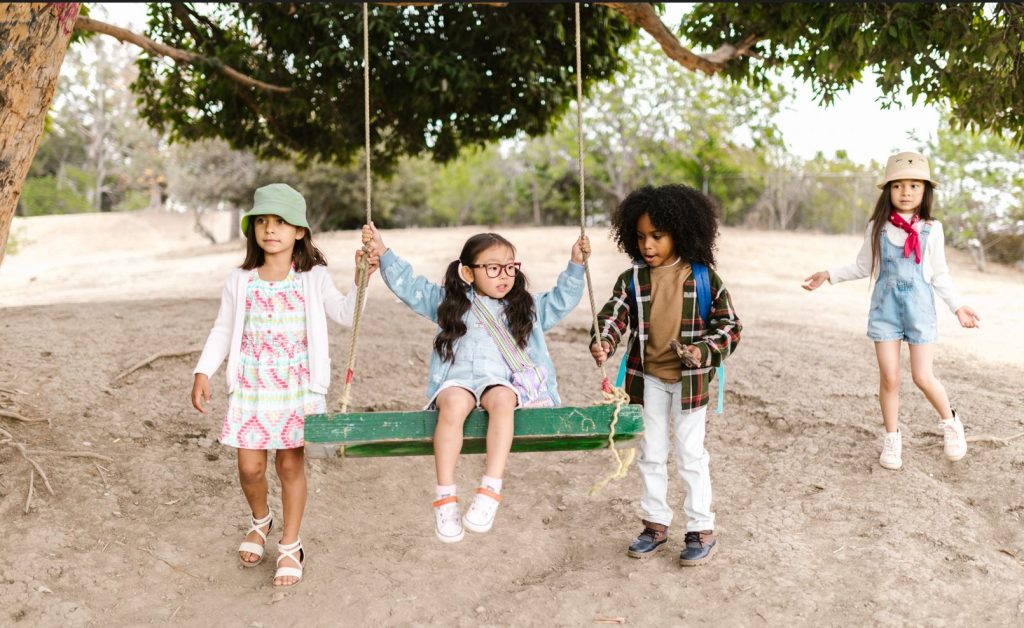Children’s engagement with and belonging to their environments.
Recent years have brought focus to the importance of understanding context when approaching the topic of child wellbeing, with both theoretical and empirical evidence mounting to support this movement (Bronfenbrenner, 1979; Coulton & Spilsbury, 2014). Whilst research has most typically investigated the contexts of family, school, and socioeconomic status when studying children (Goswami, 2012; Lee & Yoo, 2015; Gross-Manos & Massarwi, 2022), this contribution, premised on children’s rights and their participatory perspective, emphasizes the importance of also exploring the environment and nature as contexts which shape children’s lives.

Defining the meanings of ‘environment’ and ‘nature’ is not an easy task, in fact, it is often a problematic one, as people may experience and understand the same surroundings in broad and varied ways. Classically, nature is the term used to refer to an outdoor space, separated from humans. However, the environment refers to the connection which people have to a place, including the meanings, values, and interactions they associate with a physical space (Spiteri et al., 2022). Highlighting and examining the role of the environment and nature in children’s lives will help elevate current understandings of the importance of context for children.

A key environment to consider in a child’s life is their neighborhood. Neighborhoods usually refer to urban areas, villages, or villages in rural areas, and these areas are not simply geographical territories, they are units of social organization that symbolize meaning to people as places to live, work and perform their daily tasks. The neighborhoods in which children reside are a space in which they are likely to spend a great amount of time in, so they represent important contexts in their lives (Allison et al., 1999). Research has shown that neighborhoods and their characteristics can influence children’s well-being (Rees, 2017).

Within their environment, children must feel free to play and experiment, feel secure to succeed or fail at tasks, and push themselves. For children, such activities are a part of their process of socialization, which is crucial to their development and well-being. Specifically, recent studies have shown that the natural environment of a child, a place in which they may engage with various components and explore, has a great contribution to their well-being. Furthermore, research has indicated that active engagement by children with their environment is associated with various developmental benefits, like igniting a sense of independence and autonomy, and providing a range of other physical, cognitive, and affective benefits (Adams & Savahl, 2017).

Another important environment in a child’s life is the climate in which they live. Thinking on a bigger scale, there is growing evidence that humans are negatively impacting climate change, and this may hold negative repercussions on the well-being of children. As climate change worsens, it is more likely that children of future generations will be most heavily impacted by these changes. Moreover, growing media coverage of the negative consequences relating to global climate change has caused growing eco-anxiety among children and youth. Eco-anxiety, also known as climate distress or climate anxiety, is the anxiety one may experience relating to the global climate crisis and the impending threat of environmental disaster, causing symptoms like panic attacks, insomnia, and obsessive thinking (Cianconi et al., 2020), and this is harmful to children. Also, the wish to protect nature and climate also leads to a growing number of children and young people all over the world being involved in demonstrations and different actions.

In summary, considering the importance of nature and the environment as influential contexts in children’s lives these contexts must be recognized as an issue relating to children’s rights. Also, bearing in mind that children are the experts of their lives, it is imperative to talk to and learn from them directly regarding the importance of these contexts for them. Lastly, it is clear that we must recognize the efforts of children in dealing with the issue of climate change and appreciate their importance in this fight.

Asher Ben-Arieh, is the Haruv Chair for the study of Child Maltreatment at the Hebrew University of Jerusalem, a Prof. of Social Work and the Dean of the Paul Baerwald School of Social Work and Social Welfare as of September 2021. Asher is also the director of the Haruv Institute in Jerusalem. He served for 20 years as the associate director of Israel’s National Council for the Child.

References
Adams, S., & Savahl, S. (2017). Nature as children’s space: A systematic review. The Journal of Environmental Education, 48(5), 291-321.
Allison, K. W., Crawford, I., Leone, P. E., Trickett, E., Perez-Febles, A., Burton, L. M., & Le Blanc, R. (1999). Adolescent substance use: Preliminary examinations of school and neighborhood context. American journal of community psychology, 27(2), 111-141.
Bronfenbrenner, U. (1979). The Ecology of Human Development: Experiments by Nature and Design. Harvard University Press.
Cianconi, P., Betrò, S., & Janiri, L. (2020). The impact of climate change on mental health: a systematic descriptive review. Frontiers in psychiatry, 74.
Coulton, C. J., & Spilsbury, J. C. (2014). Community and Place-Based Understanding of Child Well-Being. In Handbook of Child Well-Being (pp. 1307–1334). Springer Netherlands. https://doi.org/10.1007/978-90-481-9063-8_54
Gross-Manos, D., & Massarwi, A. A. (2022). Material deprivation and subjective poverty association with subjective well-being reported by children: Religiosity as a protective factor. American Journal of Orthopsychiatry.
Goswami, H. (2012). Social Relationships and Children’s Subjective Weil-Being. Social Indicators Research, 107(3), 575–588. http://www.jstor.org/stable/41476594
Lee, B.J., Yoo, M.S. Family, School, and Community Correlates of Children’s Subjective Well-being: An International Comparative Study. Child Ind Res 8, 151–175 (2015). https://doi.org/10.1007/s12187-014-9285-z
Rees, G. (2017). Children’s Views on Their Lives and Well-being. Springer Cham. DOI: 10.1007/978-3-319-65196-5
Spiteri, J., Higgins, P., & Nicol, R. (2022). It’s like a Fruit on a Tree: Young Maltese Children’s Understanding of the Environment. Early Child Development and Care, 192(7), 1133-1149.